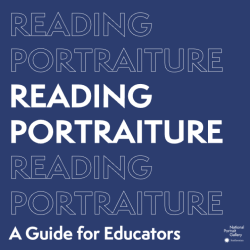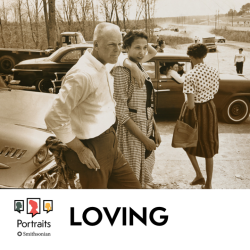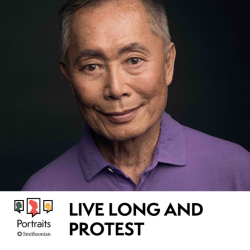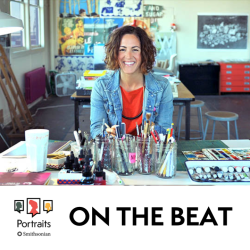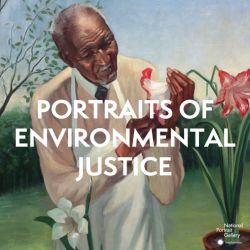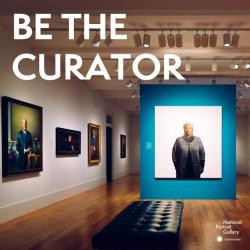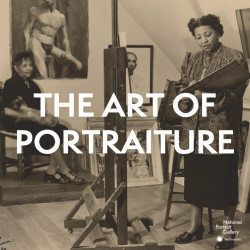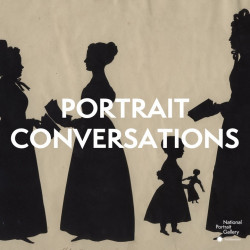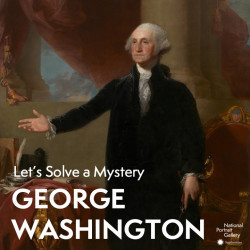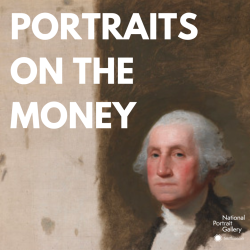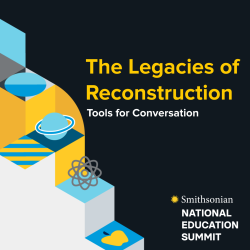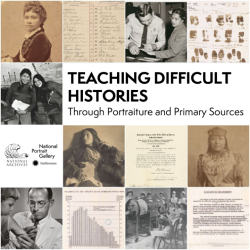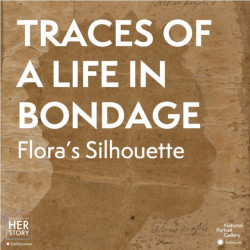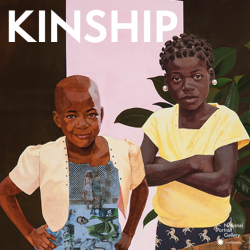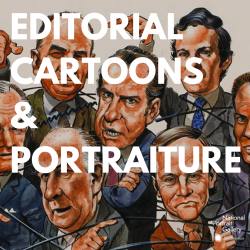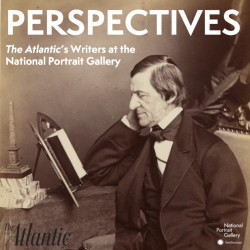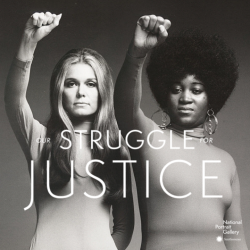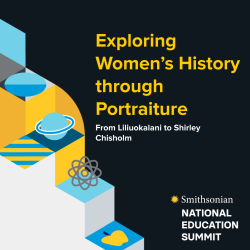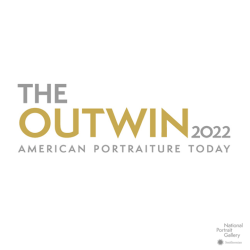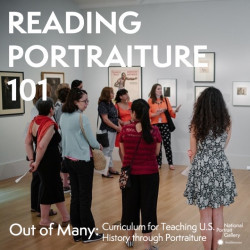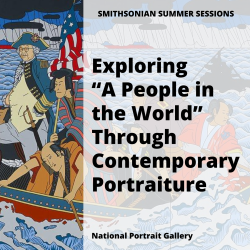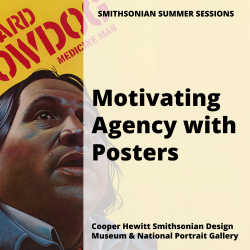Nicole Vance's collections
Looking Ahead: What Kind of Nation Do We Want to Be?
<p>How can the past inform our future? Imagine you are living in the U.S. in 1899. In this era of rapid expansion and increasing tensions many Americans are asking "what kind of nation do we want to be?" Across the United States, people are talking about what that means for themselves and for their country. For this lesson, students will imagine they are gathered in an issue forum. This guide is meant to provide a framework for student deliberation by offering three approaches to the complex question: "what kind of nation do we want to be?" Each option is accompanied by possible actions to be taken and notes possible drawbacks.</p>
<p>#NPGteach</p>
 Nicole Vance
Nicole Vance
18
Reading Portraiture: A Guide for Educators
<p>The National Portrait Gallery tells the story of the United States by portraying the people who shape the nation’s history, development, and culture. These individuals understand who we are and remind us of what we can aspire to be.</p>
<p>In this guide, you will discover how to teach students to spot visual clues in portraits and then analyze them, similar to dissecting a historical document. Teaching students to use close reading skills with portraiture will produce a rich and memorable investigation of both the sitter and the artist. Use the close looking strategies in this collection as a springboard for classroom conversations. Portraits present insights into history and biography, prompt writing in the classroom, inspire students to create self-portraits, and even offer great ties to science and mathematics.<br></p>
<p>The Learning to Look strategies in this guide offer unique ways to engage in close looking and portraiture with your students. The Elements of Portrayal provide more guiding questions to help you and your students learn how to read portraiture.</p>
<p>#NPGteach</p>
<p>#SummerSessions<br></p>
 Nicole Vance
Nicole Vance
85
PORTRAITS Podcast: Loving
<p>In this lesson, students will learn about historical taboos around relationships and race in the United States using a portrait of Richard and Mildred Loving. They will analyze contemporary societal norms around relationship diversity along ethnic, religious, and/or class lines.</p>
<p>This lesson plan was written by NPG Teen Programs Specialist, Sahtiya H. Hammell.</p>
 Nicole Vance
Nicole Vance
19
Be the Curator
<p>This Learning Lab complements the National Portrait Gallery's student program, Be the Curator. <br></p>
<p>Students will learn about the exhibition process, by touring and reviewing exhibitions, uncovering the roles of curators and exhibition designers, finding themes in exhibitions, and writing museum label text. The program culminates in a hands-on project where students will create their own thematic exhibition from objects in the National Portrait Gallery's collection.<br></p>
<p><strong>Objectives:</strong></p>
<ul><li>Understand the roles of the museum curator and the exhibition designer in a museum </li><li>Work to relate artworks to one another and find a common theme </li><li>Write museum labels that clearly communicate ideas to an audience </li><li>Estimate, measure, and calculate scale </li></ul>
<p>#NPGteach</p>
 Nicole Vance
Nicole Vance
98
The Art of Portraiture
<p>This Learning Lab Collection complements the National Portrait Gallery student program, The Art of Portraiture.</p>
<p>Students will take a close look at modern and contemporary portraiture through the lens of artists’ decisions, paying particular attention to the different approaches that artists take to their subject matter and the different processes that they use in making their art.<br></p>
<p>#NPGteach<br></p>
<p>Objectives:</p>
<ul><li>Examine modern and contemporary portraiture and identify, compare, and contrast visual elements in the portrait.</li><li>Identify and analyze the contributions of modern and contemporary Americans to U.S. history and society.</li><li>Discuss the specific choices an artist has made in his or her portraits.</li><li>Discuss the relevancy of portraiture as a contemporary art form.</li></ul><p>Learn more about our <a href="https://npg.si.edu/teachers/school-groups">virtual 2020-2021 student programs</a> and explore more of the <a href="https://learninglab.si.edu/org/npg">National Portrait Gallery's Learning Lab collections</a>.</p>
<p>Keywords: Portraiture, Painting, Sculpture, Photography, Mixed Media, Video Art, Engraving, Printmaking, Artist, Contemporary, Artistic Style, Symbols, Biography, Self-Portrait</p>
<p></p>
 Nicole Vance
Nicole Vance
48
Portrait Conversations
<p>This Learning Lab Collection complements the National Portrait Gallery student program Portrait Conversations.</p>
<p></p>
<p>Through this discussion based program students will compare and contrast visual elements in portraits across different historical eras, paying particular attention to differences in style and media and to the variety of historical contributions represented. Students will read portraiture by identifying and analyzing the elements of portrayal to learn about the biography of the sitter.</p>
<p></p>
<p>#NPGteach</p>
 Nicole Vance
Nicole Vance
54
Legacies of Reconstruction: Tools for Conversation
<p>Why is Reconstruction relevant today? This collection engages learners with inquiry and object-based learning strategies to support conversations about our racial past and consider the relevance of Reconstruction's legacies. With a focus on drawing connections between past and present, this collection seeks to empower educators and students by introducing them to new ideas for integrating art into conversations about Reconstruction. </p>
<p>This Smithsonian Education Summit workshop was facilitated by Elizabeth Dale-Deines (Smithsonian American Art Museum), Candra Flanagan (National Museum of African American History and Culture), and Briana Zavadil White (National Portrait Gallery).<br></p>
<ul></ul>
<p>#NationalEducationSummit #NPGteach<br></p>
 Nicole Vance
Nicole Vance
50
Teaching Difficult Histories with Primary Sources and Portraiture
<p>How do we teach a balanced, comprehensive, and complex history of the United States? In this collection, explore themes of civil rights, American imperialism, Native histories, the ethics of medicine, and more. Through document analysis and reading portraiture strategies, uncover previously unknown stories and consider the pressures and motivations that shaped historical controversies. <br></p>
<p>This Learning Lab collection has been created in conjunction with the Teaching Difficult Histories Through Portraiture and Primary Sources professional development workshop, co-hosted by the National Portrait Gallery and the National Archives and Records Administration, in August 2023.<strong></strong><strong></strong></p>
<p>#NPGteach</p>
 Nicole Vance
Nicole Vance
83
Traces of a Life in Bondage: Flora’s Silhouette
<p>This collection focuses on a life-size, hand-cut silhouette representing Flora (1777–1815), a woman who was enslaved in Connecticut, and the bill of sale that transferred her ownership on December 13, 1796, when she was nineteen years old. Her life story invites us to consider the period from the American Revolution to the close of the War of 1812 from a rarely considered perspective—that of an enslaved woman. Flora is emblematic of vast numbers of enslaved women whose likenesses and histories have gone unrecorded.</p>
<p>Her silhouette was traced at life-size directly from her cast shadow, lending a tangible sense of human presence to her portrait. But who made it? And for what purpose? We will explore these questions through consideration of the few facts known about Flora's life; the regional differences that distinguished the experiences of enslaved women in the North and in the South; the social conventions of silhouette-making; and the history of representing African American women in late eighteenth and nineteenth-century American portraiture.</p>
<p>This project received support from the Smithsonian American Women's History Initiative.</p>
<p>#NPGteach</p>
 Nicole Vance
Nicole Vance
57
Our Struggle for Justice: A Digital Collaboration between the National Portrait Gallery & Capital One
<p><em>What can you do to make a difference?</em> Introducing <a href="https://npg.si.edu/visit-home/digital-engagement">Our Struggle for Justice</a>, a digital collaboration between the <a href="https://npg.si.edu/">National Portrait Gallery</a> and <a href="https://www.capitalone.com/">Capital One</a> that explores activism and social justice through biography.<br><br></p>
<p>How can you use your skills to spark conversation, create agency and inspire change? In this collection, meet individuals, past and present, from the museum’s collection whose thoughts and actions have made our nation better. Each featured individual is accompanied by thought-provoking questions, educational resources, and additional portraits to reframe the way we view activism and the causes closest to us.<br></p>
<p>Join us on <a href="https://www.instagram.com/smithsoniannpg/">Instagram</a> and <a href="https://twitter.com/smithsoniannpg">Twitter</a>, follow #OurStruggleForJustice for the latest updates, and look out for new posts each Tuesday. </p>
<hr>
<p>Through our Twitter and Instagram, we will delve into the museum’s collection to contextualize the pursuit of freedom and activism in the United States, sparking conversation and inspiring action. </p>
<p>Our country was established on two basic principles: freedom and the pursuit of happiness. However, over the course of our history, these ideals have been broken, tested and reconstructed. Many times, the onus for upholding the nation’s moral foundation has fallen to the individual rather than the majority. </p>
<p>American activism guides our nation toward its true vision, one that acts upon the ideals of its founding and celebrates the entirety of its population. And while many before us defined what it means to strive for a better America, there is no question that this work is ongoing. </p>
<p>Through Our Struggle for Justice, we will meet individuals, past and present, whose thoughts and actions have made our nation better. Though their experiences and causes vary, these people have one thing in common: they fought tirelessly against injustice, using their time, strengths and sheer will to create meaningful change. </p>
<p>In telling these stories, we aim to spark conversations around agency. Look for thought-provoking questions to reframe the way we think about activism and the causes that are closest to us. <br></p>
<p>The campaign draws inspiration from the Portrait Gallery’s collection, including the permanent exhibition The Struggle for Justice, which celebrates pioneers and change-makers in the fight for social equity. </p>
<p>One person can make a difference. In learning about these figures, we hope that you can, too. <br></p>
 Nicole Vance
Nicole Vance
112
Exploring Women's History Through Portraiture: From Liliuokalani to Shirley Chisholm (Smithsonian National Education Summit)
<p>How can women's stories centered in the classroom? In what ways can portraiture spark civic change? This collection features portraits, strategies, and lessons for teaching about the history of women in the United States to support the 2022 <em>Smithsonian National Education Summit</em> session, "Exploring Women's History Through Portraiture: From Liliuokalani to Shirley Chisholm." With a focus on drawing connections to the present, this collection seeks to empower educators and students by introducing them to new ideas for integrating art, and civics that center on stories of women. </p>
<p>Workshop facilitated by Ashleigh Coren (Smithsonian American Women's History Initiative and National Portrait Gallery), Briana Zavadil White (National Portrait Gallery), and Amy Trenkle (Ida B Wells MS). <br></p>
<p><strong>Learning Objectives</strong></p>
<p>Educators will:</p>
<ul><li>Identify elements of portrayal in order to read portraiture </li><li>Learn about hidden histories of women</li><li>Examine the importance of sharing different historical perspectives</li><li>Collaboratively brainstorm how to integrate resources into the classroom.</li></ul>
<p>#NationalEducationSummit #TogetherWeThrive #NPGteach<br></p>
 Nicole Vance
Nicole Vance
24
The Outwin 2022: American Portraiture Today
<p>Explore portraits from <em>The Outwin 2022: American Portraiture Today </em>at the National Portrait Gallery in this Learning Lab collection.</p>
<p><em></em><em>The Outwin 2022: American Portraiture Today</em> presents 42 portraits selected through an open call that garnered more than 2,700 entries from artists working across the United States and Puerto Rico. The artists responded with works that engage contemporary society, many providing new insights into the unprecedented reality we have experienced in the time surrounding the COVID-19 pandemic.</p>
<p>The selected finalists create artworks in a wide range of media, including painting, drawing, photography, sculpture, textiles, video, and performance. They demonstrate how capacious and changing the genre of portraiture can be, and illuminate the genre's power to make visible a multitude of life experiences.<br></p>
<p>To best view the video and performance pieces, visit the <em>The Outwin 2022: American Portraiture Today</em><em>'s </em><a href="https://portraitcompetition.si.edu/exhibition/2022-outwin-boochever-portrait-competition/?lang=eng">website</a>.</p>
<p>Every three years, the National Portrait Gallery invites both emerging and established artists working in the U.S. to submit a recent portrait to the Outwin Boochever Portrait Competition. Around fifty works are then selected by expert jurors who, on average, review more than 2,500 entries. The competition has evolved since its inception in 2006 to include performance art and time-based media alongside painting, photography, drawing, and sculpture.</p>
<p>As part of its deep commitment to supporting contemporary artists working in portraiture, the National Portrait Gallery looks to the Outwin to share the genre’s remarkable relevance and strengthen the visual representation of American history. Each iteration of the competition gauges portraiture’s progression while underscoring the potential of one person to make an impact.</p>
<p>The Outwin is made possible through the Virginia Outwin Boochever Portrait Competition Endowment, established by Virginia Outwin Boochever (1920–2005), who served as a docent for the National Portrait Gallery for nearly two decades. Mrs. Boochever’s vision for the Outwin is now carried out by her children.</p>
<p>Educators, to explore these portraits with your students through close looking and visible thinking routines, see the resources at the end of this collection for ideas.</p>
<p>#NPGteach</p>
 Nicole Vance
Nicole Vance
60


